technical data MERCEDES-BENZ GLC SUV 2015 Owners Manual
[x] Cancel search | Manufacturer: MERCEDES-BENZ, Model Year: 2015, Model line: GLC SUV, Model: MERCEDES-BENZ GLC SUV 2015Pages: 497, PDF Size: 15.27 MB
Page 6 of 497
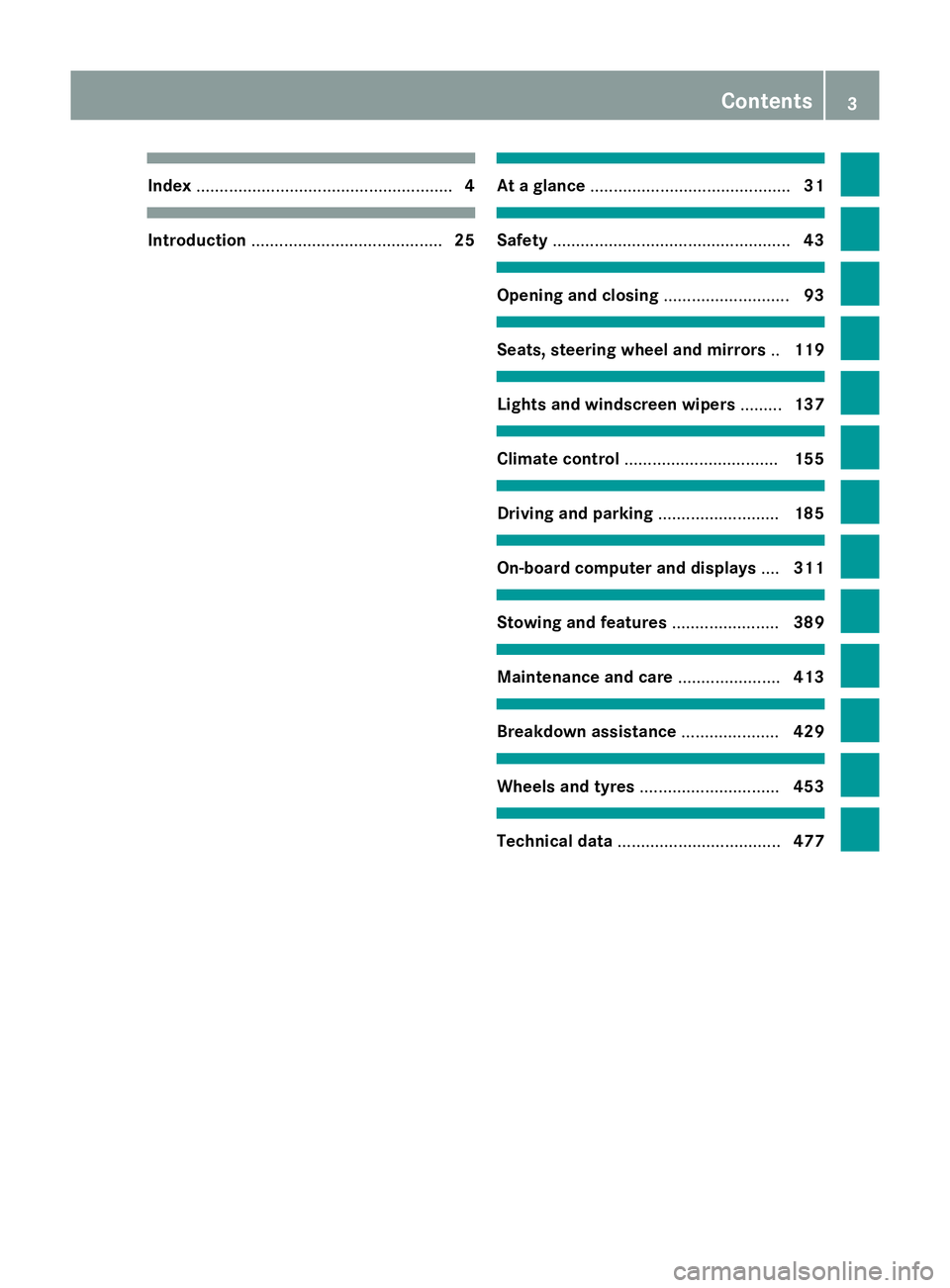
Index
....................................................... 4Introduction
......................................... 25 At a glance
........................................... 31 Safety
................................................... 43 Opening and closing
...........................93 Seats, steering wheel and mirrors
..119 Lights and windscreen wipers
.........137 Climate control
................................. 155 Driving and parking
..........................185 On-board computer and displays
....311 Stowing and features
.......................389 Maintenance and care
......................413 Breakdown assistance
.....................429 Wheels and tyres
.............................. 453 Technical data
................................... 477 Contents
3
Page 11 of 497
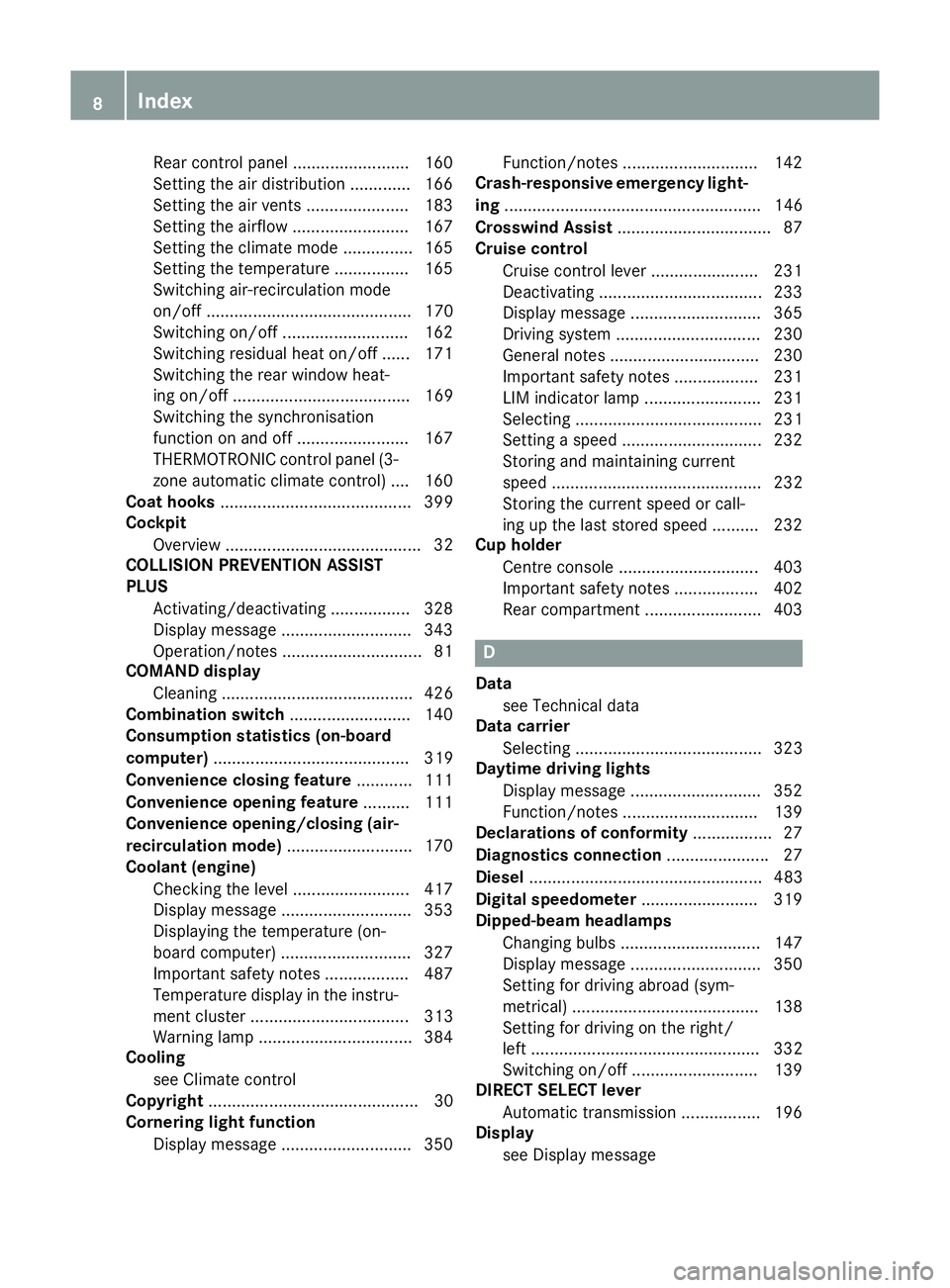
Rear control panel ........................
.160
Setting the air distribution ............. 166
Setting the air vents ..................... .183
Setting the airflow ......................... 167
Setting the climate mode .............. .165
Setting the temperature ................ 165
Switching air-recirculation mode
on/off ............................................ 170
Switching on/off ........................... 162
Switching residual heat on/off ...... 171
Switching the rear window heat-
ing on/off ...................................... 169
Switching the synchronisation
function on and off ........................ 167
THERMOTRONIC control panel (3- zone automatic climate control) .... 160
Coat hooks ......................................... 399
Cockpit
Overview .......................................... 32
COLLISION PREVENTION ASSIST
PLUS
Activating/deactivating ................. 328
Display message ............................ 343
Operation/notes .............................. 81
COMAND display
Cleaning ......................................... 426
Combination switch .......................... 140
Consumption statistics (on-board
computer) .......................................... 319
Convenience closing feature ............ 111
Convenience opening feature .......... 111
Convenience opening/closing (air-
recirculation mode) ........................... 170
Coolant (engine)
Checking the level ......................... 417
Display message ............................ 353
Displaying the temperature (on-
board computer) ............................ 327
Important safety notes .................. 487
Temperature display in the instru- ment cluster .................................. 313
Warning lamp ................................. 384
Cooling
see Climate control
Copyright ............................................. 30
Cornering light function
Display message ............................ 350 Function/notes ............................
.142
Crash-responsive emergency light-
ing ....................................................... 146
Crosswind Assist ................................. 87
Cruise control
Cruise control lever ....................... 231
Deactivating ................................... 233
Display message ............................ 365
Driving system ............................... 230
General notes ................................ 230
Important safety notes .................. 231
LIM indicator lamp ......................... 231
Selecting ........................................ 231
Setting a speed .............................. 232
Storing and maintaining current
speed ............................................. 232
Storing the current speed or call-
ing up the last stored speed .......... 232
Cup holder
Centre console .............................. 403
Important safety notes .................. 402
Rear compartment ......................... 403 D
Data see Technical data
Data carrier
Selecting ........................................ 323
Daytime driving lights
Display message ............................ 352
Function/notes ............................ .139
Declarations of conformity ................. 27
Diagnostics connection ......................27
Diesel .................................................. 483
Digital speedometer .........................319
Dipped-beam headlamps
Changing bulbs .............................. 147
Display message ............................ 350
Setting for driving abroad (sym-
metrical) ........................................ 138
Setting for driving on the right/
left ................................................. 332
Switching on/off ........................... 139
DIRECT SELECT lever
Automatic transmission ................. 196
Display
see Display message 8
Index
Page 13 of 497
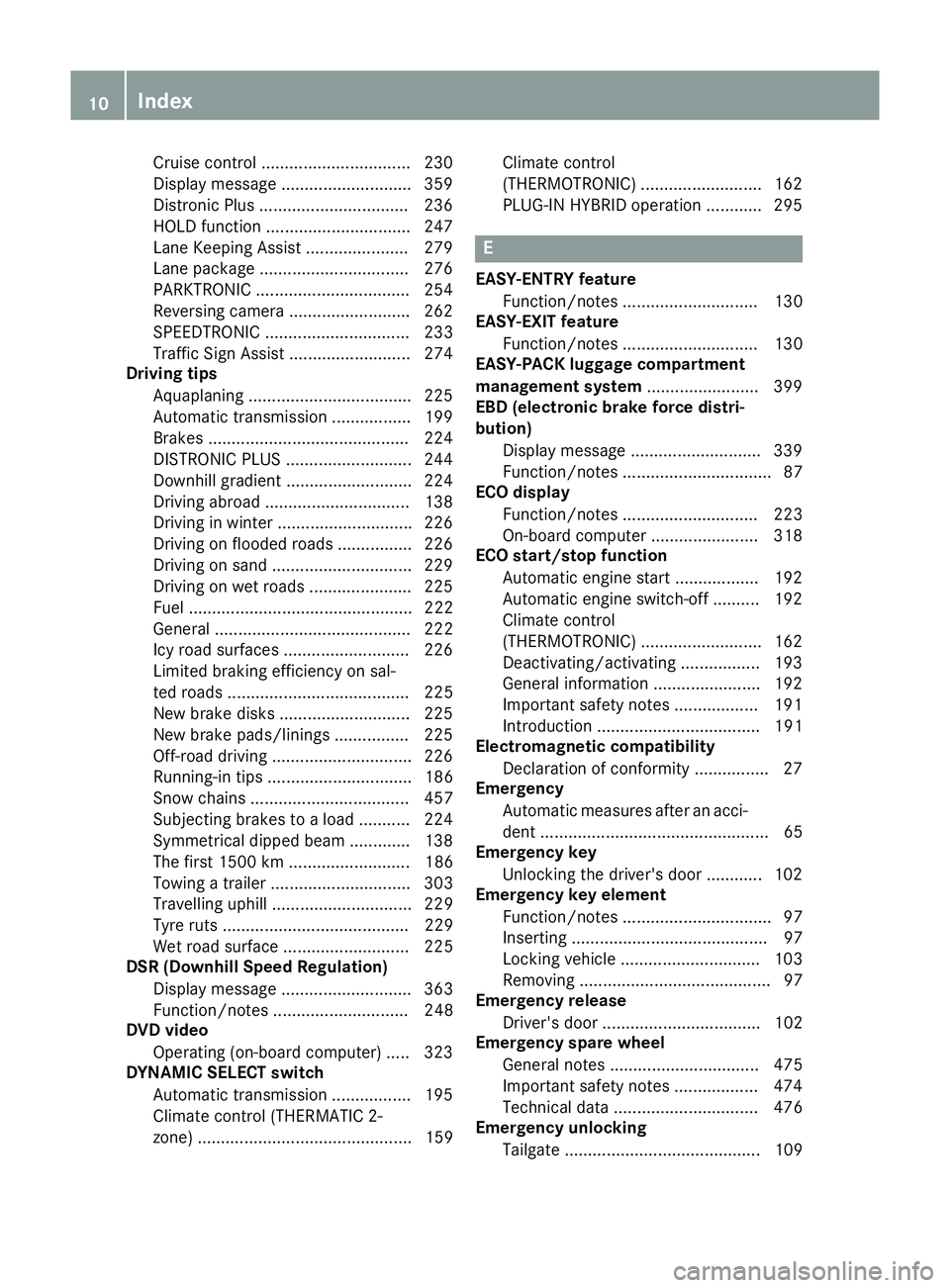
Cruise control ................................ 230
Display message ............................ 359
Distronic Plus ................................ 236
HOLD function ..............................
.247
Lane Keeping Assist ..................... .279
Lane package ................................ 276
PARKTRONIC ................................. 254
Reversing camera .......................... 262
SPEEDTRONIC ............................... 233
Traffic Sign Assist .......................... 274
Driving tips
Aquaplaning ................................... 225
Automatic transmission ................. 199
Brakes .......................................... .224
DISTRONIC PLUS ........................... 244
Downhill gradient ........................... 224
Driving abroad ............................... 138
Driving in winter ............................ .226
Driving on flooded roads ................ 226
Driving on sand .............................. 229
Driving on wet roads ..................... .225
Fuel ................................................ 222
General .......................................... 222
Icy road surfaces ........................... 226
Limited braking efficiency on sal-
ted roads ....................................... 225
New brake disks ............................ 225
New brake pads/linings ................ 225
Off-road driving .............................. 226
Running-in tips ............................... 186
Snow chains .................................. 457
Subjecting brakes to a load ........... 224
Symmetrical dipped bea m............. 138
The first 1500 km .......................... 186
Towing a trailer .............................. 303
Travelling uphill .............................. 229
Tyre ruts ........................................ 229
Wet road surface ........................... 225
DSR (Downhill Speed Regulation)
Display message ............................ 363
Function/note s............................. 248
DVD video
Operating (on-board computer) ..... 323
DYNAMIC SELECT switch
Automatic transmission ................. 195
Climate control (THERMATIC 2-
zone) .............................................. 159 Climate control
(THERMOTRONIC) .......................... 162
PLUG-IN HYBRID operation ............ 295 E
EASY-ENTRY feature Function/note s............................. 130
EASY-EXIT feature
Function/note s............................. 130
EASY-PACK luggage compartment
management system ........................ 399
EBD (electronic brake force distri-
bution)
Display message ............................ 339
Function/note s................................ 87
ECO display
Function/note s............................. 223
On-board computer ....................... 318
ECO start/stop function
Automatic engine start .................. 192
Automatic engine switch-off .......... 192
Climate control
(THERMOTRONIC ).......................... 162
Deactivating/activating ................. 193
General information ....................... 192
Important safety notes .................. 191
Introduction ................................... 191
Electromagnetic compatibility
Declaration of conformity ................ 27
Emergency
Automatic measures after an acci-
dent ................................................. 65
Emergency key
Unlocking the driver's door ............ 102
Emergency key element
Function/note s................................ 97
Inserting .......................................... 97
Locking vehicle .............................. 103
Removing ......................................... 97
Emergency release
Driver's door .................................. 102
Emergency spare wheel
General notes ................................ 475
Important safety notes .................. 474
Technical data ............................... 476
Emergency unlocking
Tailgate .......................................... 109 10
Index
Page 24 of 497
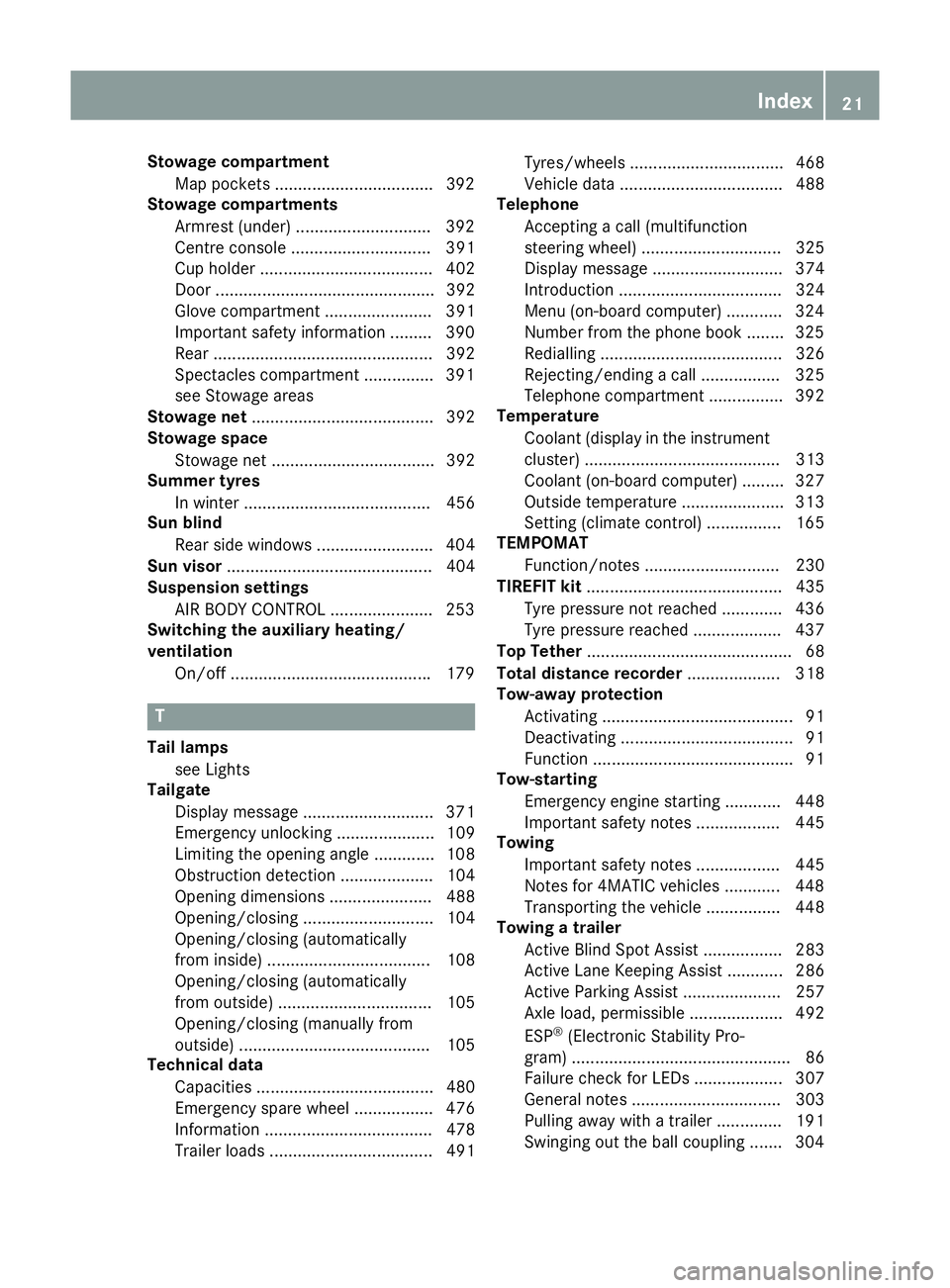
Stowage compartment
Map pockets ..................................3 92
Stowage compartments
Armrest (under) ............................ .392
Centre console .............................. 391
Cup holder ..................................... 402
Door ............................................... 392
Glove compartment ....................... 391
Important safety information ......... 390
Rear ............................................... 392
Spectacles compartment .............. .391
see Stowage areas
Stowage net ....................................... 392
Stowage space
Stowage net ................................... 392
Summer tyres
In winter ........................................ 456
Sun blind
Rear side windows ......................... 404
Sun visor ............................................ 404
Suspension settings
AIR BODY CONTROL ..................... .253
Switching the auxiliary heating/
ventilation
On/off .......................................... .179 T
Tail lamps see Lights
Tailgate
Display message ............................ 371
Emergency unlocking ..................... 109
Limiting the opening angle ............. 108
Obstruction detectio n.................... 104
Opening dimensions ...................... 488
Opening/closing ............................ 104
Opening/closing (automatically
from inside) ................................... 108
Opening/closing (automatically
from outside) ................................. 105
Opening/closing (manually from
outside) ......................................... 105
Technical data
Capacities ...................................... 480
Emergency spare wheel ................. 476
Information .................................... 478
Trailer load s................................... 491 Tyres/wheels ................................. 468
Vehicle data ................................... 488
Telephone
Accepting a call (multifunction
steering wheel) .............................. 325
Display message ............................ 374
Introduction ................................... 324
Menu (on-board computer) ............ 324
Number from the phone book ........ 325
Redialling ....................................... 326
Rejecting/ending a call ................. 325
Telephone compartment ................ 392
Temperature
Coolant (display in the instrumentcluster) .......................................... 313
Coolant (on-board computer) ......... 327
Outside temperature ...................... 313
Setting (climate control )................ 165
TEMPOMAT
Function/note s............................. 230
TIREFIT kit .......................................... 435
Tyre pressure not reached ............. 436
Tyre pressure reached ................... 437
Top Tether ............................................ 68
Total distance recorder .................... 318
Tow-away protection
Activating ......................................... 91
Deactivating ..................................... 91
Function ........................................... 91
Tow-starting
Emergency engine starting ............ 448
Important safety notes .................. 445
Towing
Important safety notes .................. 445
Notes for 4MATIC vehicles ............ 448
Transporting the vehicle ................ 448
Towing a trailer
Active Blind Spot Assist ................. 283
Active Lane Keeping Assist ............ 286
Active Parking Assist ..................... 257
Axle load, permissibl e.................... 492
ESP ®
(Electronic Stability Pro-
gram) ............................................... 86
Failure check for LEDs ................... 307
General notes ................................ 303
Pulling away with a traile r.............. 191
Swinging out the ball coupling ....... 304 Index
21
Page 31 of 497
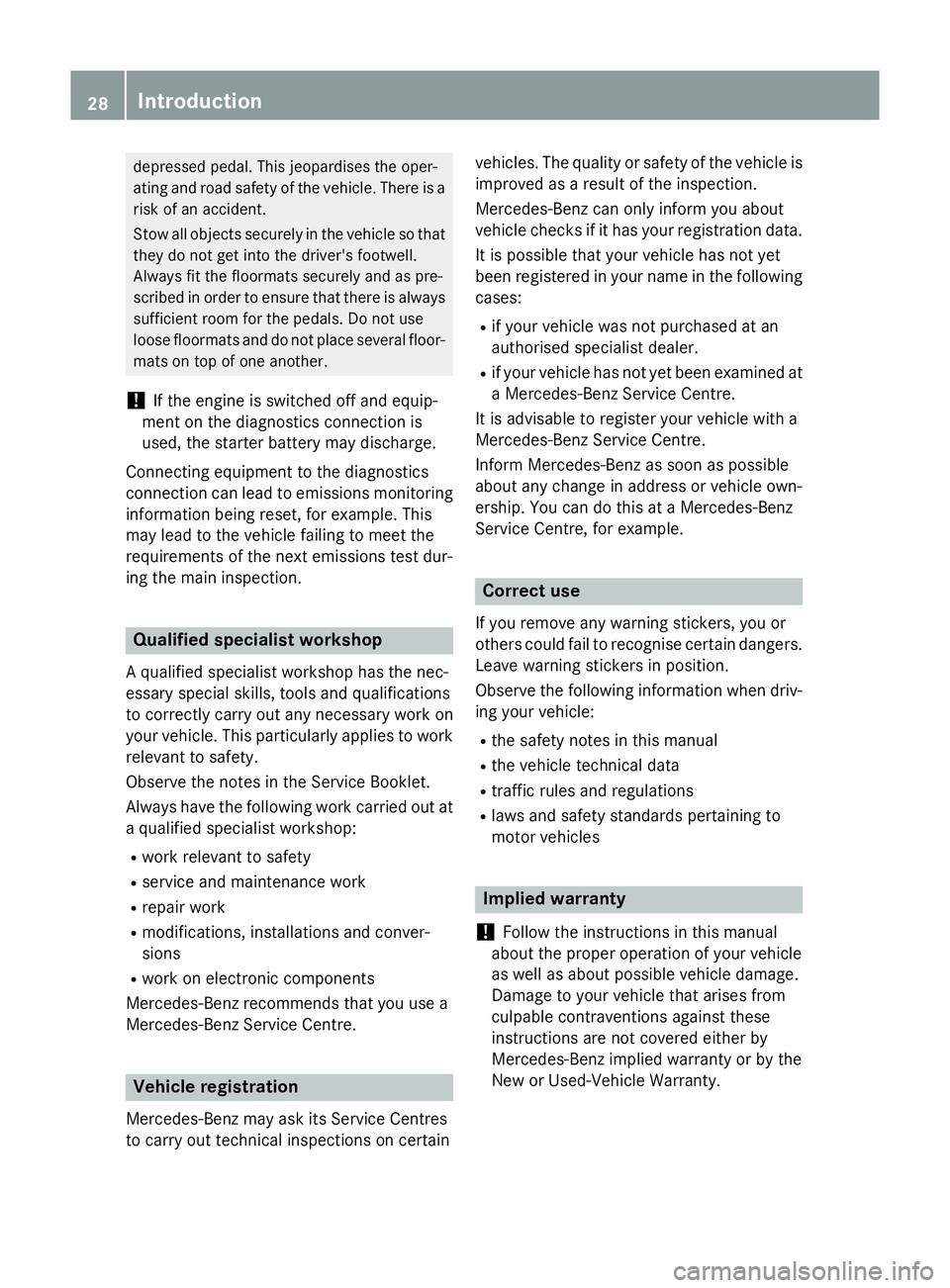
depressed pedal. This jeopardises the oper-
ating and road safety of the vehicle. There is a risk of an accident.
Stow all objects securely in the vehicle so that
they do not get into the driver's footwell.
Always fit the floormats securely and as pre-
scribed in order to ensure that there is always sufficient room for the pedals. Do not use
loose floormats and do not place several floor-mats on top of one another.
! If the engine is switched off and equip-
ment on the diagnostics connection is
used, the starter battery may discharge.
Connecting equipment to the diagnostics
connection can lead to emissions monitoring information being reset, for example. This
may lead to the vehicle failing to meet the
requirements of the next emissions test dur-
ing the main inspection. Qualified specialist workshop
A qualified specialist workshop has the nec-
essary special skills, tools and qualifications
to correctly carry out any necessary work on
your vehicle. This particularly applies to work
relevant to safety.
Observe the notes in the Service Booklet.
Always have the following work carried out at a qualified specialist workshop:
R work relevant to safety
R service and maintenance work
R repair work
R modifications, installations and conver-
sions
R work on electronic components
Mercedes-Benz recommends that you use a
Mercedes-Benz Service Centre. Vehicle registration
Mercedes-Benz may ask its Service Centres
to carry out technical inspections on certain vehicles. The quality or safety of the vehicle is
improved as a result of the inspection.
Mercedes-Benz can only inform you about
vehicle checks if it has your registration data.
It is possible that your vehicle has not yet
been registered in your name in the following
cases:
R if your vehicle was not purchased at an
authorised specialist dealer.
R if your vehicle has not yet been examined at
a Mercedes-Benz Service Centre.
It is advisable to register your vehicle with a
Mercedes-Benz Service Centre.
Inform Mercedes-Benz as soon as possible
about any change in address or vehicle own-
ership. You can do this at a Mercedes-Benz
Service Centre, for example. Correct use
If you remove any warning stickers, you or
others could fail to recognise certain dangers.
Leave warning stickers in position.
Observe the following information when driv- ing your vehicle:
R the safety notes in this manual
R the vehicle technical data
R traffic rules and regulations
R laws and safety standards pertaining to
motor vehicles Implied warranty
! Follow the instructions in this manual
about the proper operation of your vehicle
as well as about possible vehicle damage.
Damage to your vehicle that arises from
culpable contraventions against these
instructions are not covered either by
Mercedes-Benz implied warranty or by the
New or Used-Vehicle Warranty. 28
Introduction
Page 32 of 497
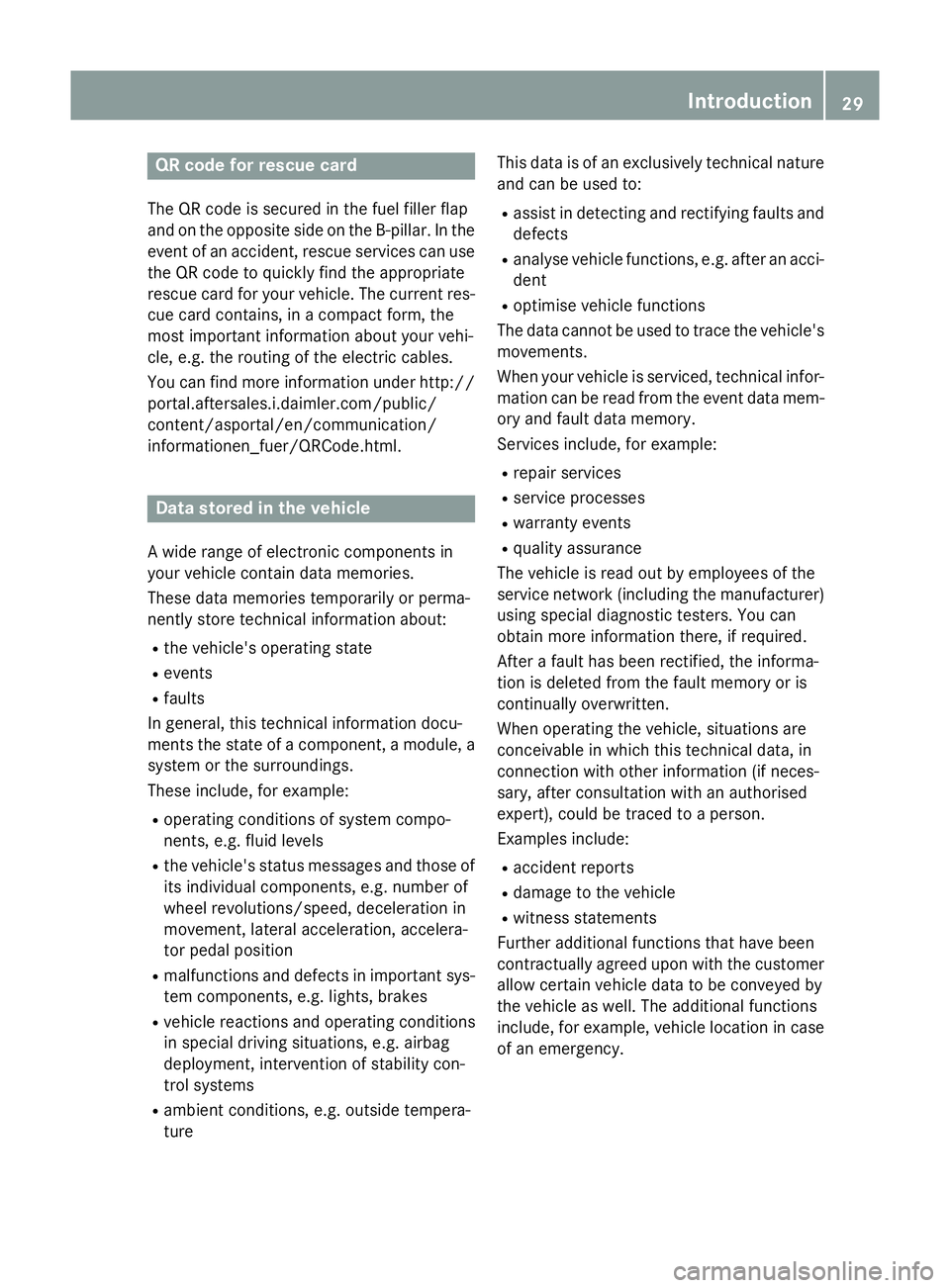
QR code for rescue card
The QR code is secured in the fuel filler flap
and on the opposite side on the B-pillar. In the
event of an accident, rescue services can use
the QR code to quickly find the appropriate
rescue card for your vehicle. The current res- cue card contains, in a compact form, the
most important information about your vehi-
cle, e.g. the routing of the electric cables.
You can find more information under http:// portal.aftersales.i.daimler.com/public/
content/asportal/en/communication/
informationen_fuer/QRCode.html. Data stored in the vehicle
A wide range of electronic components in
your vehicle contain data memories.
These data memories temporarily or perma-
nently store technical information about:
R the vehicle's operating state
R events
R faults
In general, this technical information docu-
ments the state of a component, a module, a
system or the surroundings.
These include, for example:
R operating conditions of system compo-
nents, e.g. fluid levels
R the vehicle's status messages and those of
its individual components, e.g. number of
wheel revolutions/speed, deceleration in
movement, lateral acceleration, accelera-
tor pedal position
R malfunctions and defects in important sys-
tem components, e.g. lights, brakes
R vehicle reactions and operating conditions
in special driving situations, e.g. airbag
deployment, intervention of stability con-
trol systems
R ambient conditions, e.g. outside tempera-
ture This data is of an exclusively technical nature
and can be used to:
R assist in detecting and rectifying faults and
defects
R analyse vehicle functions, e.g. after an acci-
dent
R optimise vehicle functions
The data cannot be used to trace the vehicle's movements.
When your vehicle is serviced, technical infor-
mation can be read from the event data mem- ory and fault data memory.
Services include, for example:
R repair services
R service processes
R warranty events
R quality assurance
The vehicle is read out by employees of the
service network (including the manufacturer)
using special diagnostic testers. You can
obtain more information there, if required.
After a fault has been rectified, the informa-
tion is deleted from the fault memory or is
continually overwritten.
When operating the vehicle, situations are
conceivable in which this technical data, in
connection with other information (if neces-
sary, after consultation with an authorised
expert), could be traced to a person.
Examples include:
R accident reports
R damage to the vehicle
R witness statements
Further additional functions that have been
contractually agreed upon with the customer
allow certain vehicle data to be conveyed by
the vehicle as well. The additional functions
include, for example, vehicle location in case of an emergency. Introduction
29 Z
Page 306 of 497
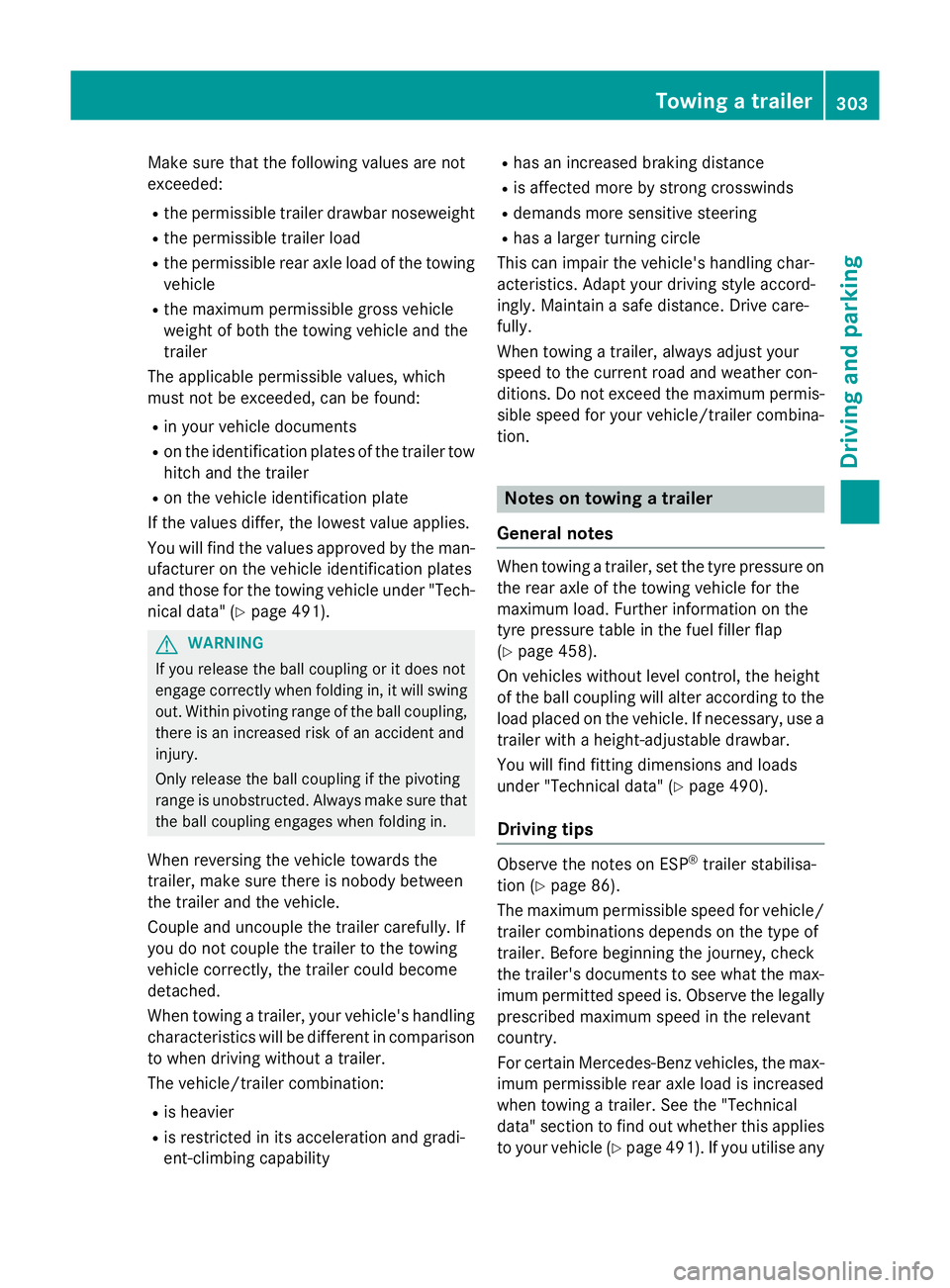
Make sure that the following values are not
exceeded:
R the permissible trailer drawbar noseweight
R the permissible trailer load
R the permissible rear axle load of the towing
vehicle
R the maximum permissible gross vehicle
weight of both the towing vehicle and the
trailer
The applicable permissible values, which
must not be exceeded, can be found:
R in your vehicle documents
R on the identification plates of the trailer tow
hitch and the trailer
R on the vehicle identification plate
If the values differ, the lowest value applies.
You will find the values approved by the man-
ufacturer on the vehicle identification plates
and those for the towing vehicle under "Tech- nical data" (Y page 491). G
WARNING
If you release the ball coupling or it does not
engage correctly when folding in, it will swing out. Within pivoting range of the ball coupling,
there is an increased risk of an accident and
injury.
Only release the ball coupling if the pivoting
range is unobstructed. Always make sure that the ball coupling engages when folding in.
When reversing the vehicle towards the
trailer, make sure there is nobody between
the trailer and the vehicle.
Couple and uncouple the trailer carefully. If
you do not couple the trailer to the towing
vehicle correctly, the trailer could become
detached.
When towing a trailer, your vehicle's handling
characteristics will be different in comparison to when driving without a trailer.
The vehicle/trailer combination:
R is heavier
R is restricted in its acceleration and gradi-
ent-climbing capability R
has an increased braking distance
R is affected more by strong crosswinds
R demands more sensitive steering
R has a larger turning circle
This can impair the vehicle's handling char-
acteristics. Adapt your driving style accord-
ingly. Maintain a safe distance. Drive care-
fully.
When towing a trailer, always adjust your
speed to the current road and weather con-
ditions. Do not exceed the maximum permis-
sible speed for your vehicle/trailer combina-
tion. Notes on towing a trailer
General notes When towing a trailer, set the tyre pressure on
the rear axle of the towing vehicle for the
maximum load. Further information on the
tyre pressure table in the fuel filler flap
(Y page 458).
On vehicles without level control, the height
of the ball coupling will alter according to the load placed on the vehicle. If necessary, use a
trailer with a height-adjustable drawbar.
You will find fitting dimensions and loads
under "Technical data" (Y page 490).
Driving tips Observe the notes on ESP
®
trailer stabilisa-
tion (Y page 86).
The maximum permissible speed for vehicle/
trailer combinations depends on the type of
trailer. Before beginning the journey, check
the trailer's documents to see what the max- imum permitted speed is. Observe the legally
prescribed maximum speed in the relevant
country.
For certain Mercedes-Benz vehicles, the max-
imum permissible rear axle load is increased
when towing a trailer. See the "Technical
data" section to find out whether this applies to your vehicle (Y page 491). If you utilise any Towing a trailer
303Driving and parking Z
Page 405 of 497
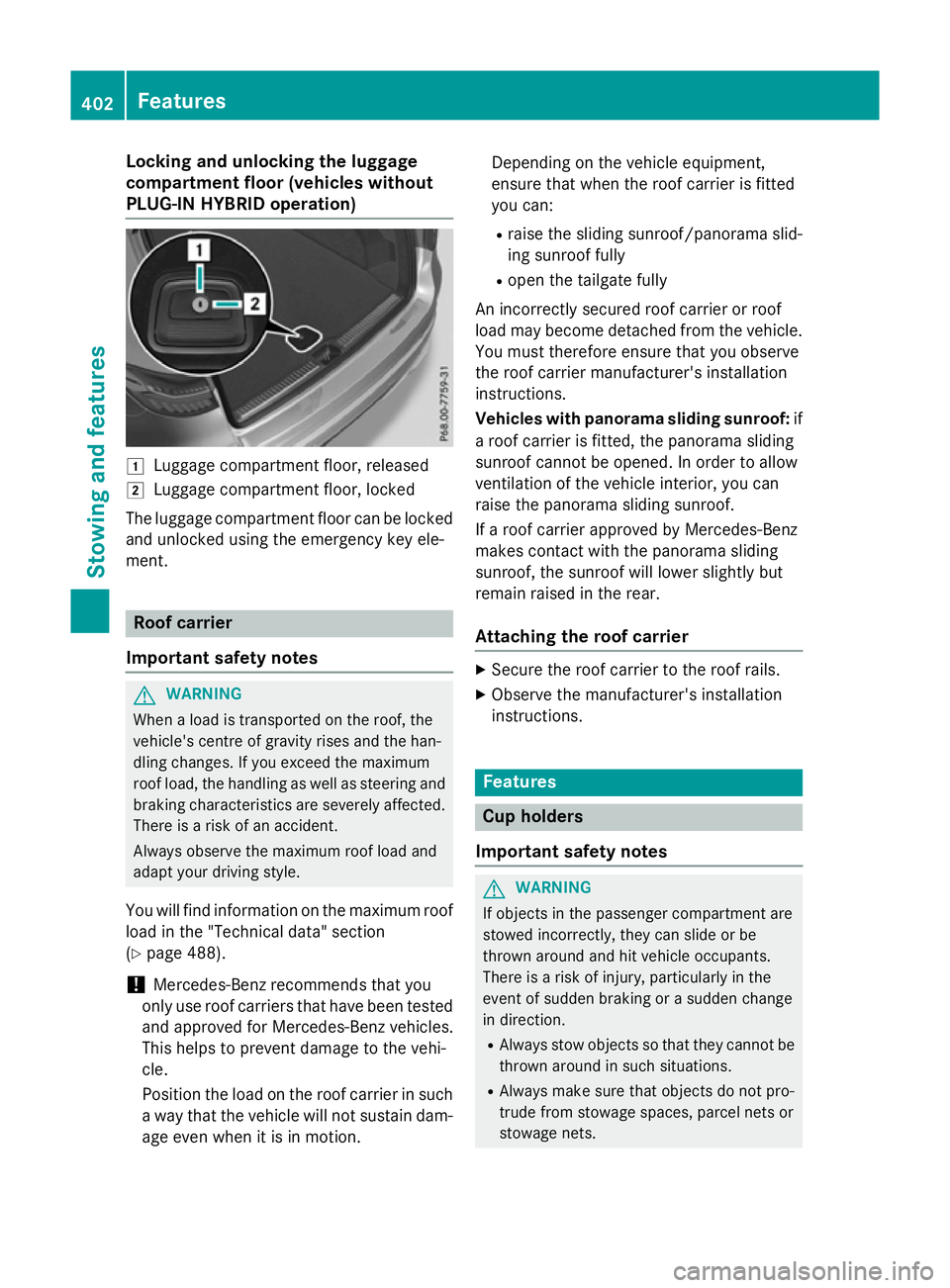
Locking and unlocking the luggage
compartment floor (vehicles without
PLUG-IN HYBRID operation) 1
Luggage compartment floor, released
2 Luggage compartment floor, locked
The luggage compartment floor can be locked
and unlocked using the emergency key ele-
ment. Roof carrier
Important safety notes G
WARNING
When a load is transported on the roof, the
vehicle's centre of gravity rises and the han-
dling changes. If you exceed the maximum
roof load, the handling as well as steering and braking characteristics are severely affected.
There is a risk of an accident.
Always observe the maximum roof load and
adapt your driving style.
You will find information on the maximum roof
load in the "Technical data" section
(Y page 488).
! Mercedes-Benz recommends that you
only use roof carriers that have been tested
and approved for Mercedes-Benz vehicles.
This helps to prevent damage to the vehi-
cle.
Position the load on the roof carrier in such
a way that the vehicle will not sustain dam-
age even when it is in motion. Depending on the vehicle equipment,
ensure that when the roof carrier is fitted
you can:
R raise the sliding sunroof/panorama slid-
ing sunroof fully
R open the tailgate fully
An incorrectly secured roof carrier or roof
load may become detached from the vehicle. You must therefore ensure that you observe
the roof carrier manufacturer's installation
instructions.
Vehicles with panorama sliding sunroof: if
a roof carrier is fitted, the panorama sliding
sunroof cannot be opened. In order to allow
ventilation of the vehicle interior, you can
raise the panorama sliding sunroof.
If a roof carrier approved by Mercedes-Benz
makes contact with the panorama sliding
sunroof, the sunroof will lower slightly but
remain raised in the rear.
Attaching the roof carrier X
Secure the roof carrier to the roof rails.
X Observe the manufacturer's installation
instructions. Features
Cup holders
Important safety notes G
WARNING
If objects in the passenger compartment are
stowed incorrectly, they can slide or be
thrown around and hit vehicle occupants.
There is a risk of injury, particularly in the
event of sudden braking or a sudden change
in direction.
R Always stow objects so that they cannot be
thrown around in such situations.
R Always make sure that objects do not pro-
trude from stowage spaces, parcel nets or
stowage nets. 402
FeaturesStowing and features
Page 478 of 497
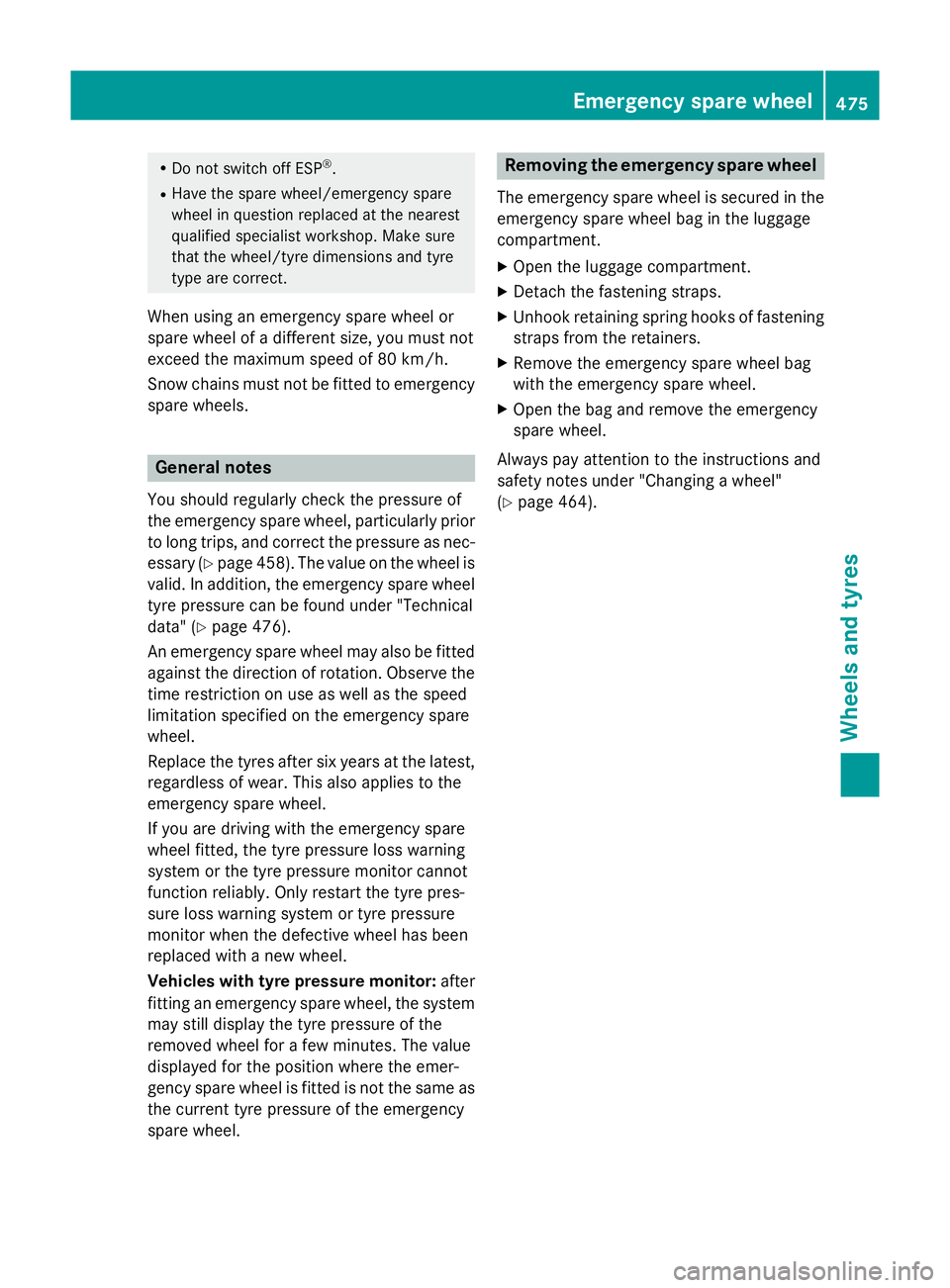
R
Do not switch off ESP ®
.
R Have the spare wheel/emergency spare
wheel in question replaced at the nearest
qualified specialist workshop. Make sure
that the wheel/tyre dimensions and tyre
type are correct.
When using an emergency spare wheel or
spare wheel of a different size, you must not
exceed the maximum speed of 80 km/h.
Snow chains must not be fitted to emergency spare wheels. General notes
You should regularly check the pressure of
the emergency spare wheel, particularly prior
to long trips, and correct the pressure as nec- essary (Y page 458). The value on the wheel is
valid. In addition, the emergency spare wheel
tyre pressure can be found under "Technical
data" (Y page 476).
An emergency spare wheel may also be fitted
against the direction of rotation. Observe the time restriction on use as well as the speed
limitation specified on the emergency spare
wheel.
Replace the tyres after six years at the latest,
regardless of wear. This also applies to the
emergency spare wheel.
If you are driving with the emergency spare
wheel fitted, the tyre pressure loss warning
system or the tyre pressure monitor cannot
function reliably. Only restart the tyre pres-
sure loss warning system or tyre pressure
monitor when the defective wheel has been
replaced with a new wheel.
Vehicles with tyre pressure monitor: after
fitting an emergency spare wheel, the system
may still display the tyre pressure of the
removed wheel for a few minutes. The value
displayed for the position where the emer-
gency spare wheel is fitted is not the same as
the current tyre pressure of the emergency
spare wheel. Removing the emergency spare wheel
The emergency spare wheel is secured in the emergency spare wheel bag in the luggage
compartment.
X Open the luggage compartment.
X Detach the fastening straps.
X Unhook retaining spring hooks of fastening
straps from the retainers.
X Remove the emergency spare wheel bag
with the emergency spare wheel.
X Open the bag and remove the emergency
spare wheel.
Always pay attention to the instructions and
safety notes under "Changing a wheel"
(Y page 464). Emergency spare
wheel
475Wheels an d tyres Z
Page 479 of 497
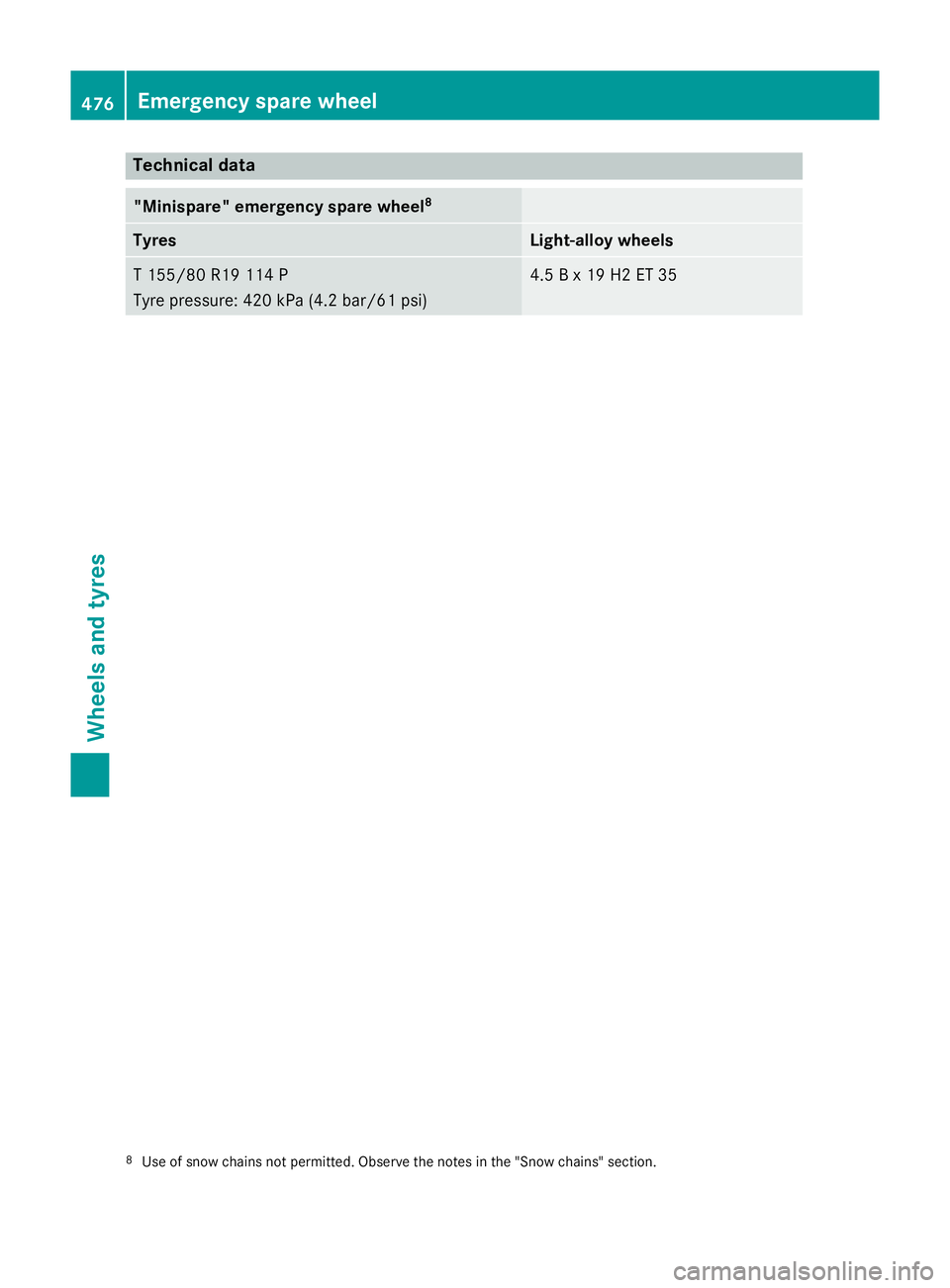
Technical data
"Minispare" emergency spare wheel
8Tyres Light-alloy wheels
T 155/8
0 R19 114 P
Tyre pressure : 420 kPa (4.2 ba r/61 psi) 4.5 B x 19 H2 ET 35
8
Use of snow chains not permitted. Observe the notes in the "Snow chains" section. 476
Emergency spare wheelWheels and tyres